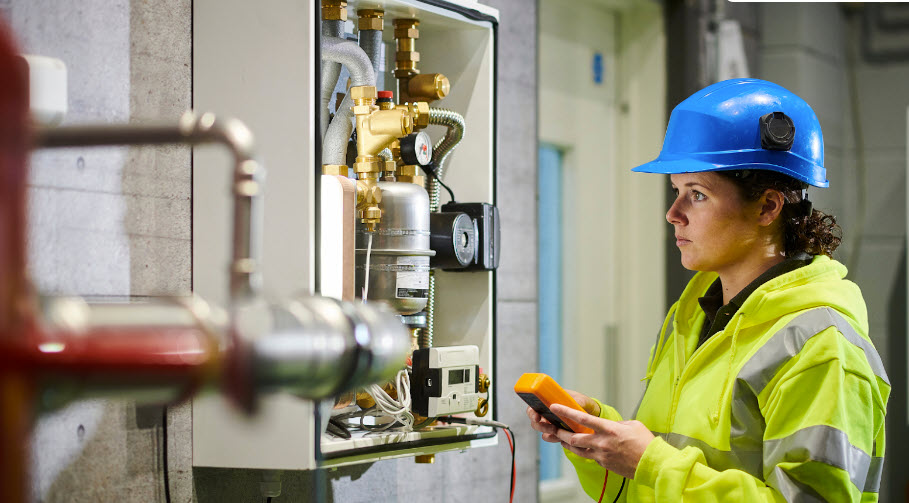The Differential Pressure Guide: The Basics You Need to Know

In the world of industrial process and pressure technology, a misunderstood and commonly overlooked component is differential pressure gauges. Differential pressure is a broad category of pressure measurement. By measuring differential pressure, you are able to easily and accurately monitor things like filter conditions, liquid levels in closed tanks, and flow rates inside pipes.
In this blog, we will overview some of the basics of differential pressure, differential pressure gauges, their applications, as well as some of the reasons that differentiate differential pressure gauges from standard pressure gauges. There is immense value in calculating differential pressure, continue reading to learn more.
Understanding Differential Pressure
Differential pressure as a concept is a simple, but vital concept to industrial process systems. It is the difference between two applied pressures. To better understand the measurement, we can look at how it is applied. For example, differential pressure is used to determine if a pipeline has any clogs as particles flow through its orifices and various filters. If a portion of the pipe is clogged, it will cause a change in pressure. This causes differential pressure to increase or decrease. At a certain point, depending on the industrial or overall process systems, an operator would need to perform maintenance on the pipeline to ensure that it's flowing efficiently again.
Another example of differential pressure application would be the pressurization of airplane cabins. It is likely that you have flown in a plane at some point in your life, and as the plane takes off, almost immediately you begin to feel a popping sensation in your ears due to a change in pressure as you rise into the sky. This is just a mild symptom of the extreme pressure change the plane is experiencing. Differential pressure is used to gauge the pressure outside of the plane in order to control the cabin pressure accordingly, ensuring that people can fly comfortably without needing an oxygen mask or experiencing serious negative health effects.
Types of Pressure Measurement
Differential pressure is only one type of pressure measurement. There are three other types: gauge, sealed, and absolutely.
Guage pressure is the most common type of pressure measurement. It is the difference between a measured point and the atmosphere. Guage pressure is used in applications such as car tire pressure, water level measurement, chamber pressure, and various hydraulic settings.
Sealed pressure is referred to as atmospheric pressure trapped within a sealed chamber. It is similar to absolute pressure (which we will get to next), however, it does not use a vacuum, but a predetermined reference point (approximately 1 bar).
Absolute pressure is the measure of the input pressure (your media) and a vacuum chamber at 0 bar. Pressure is measured independently of changes in atmospheric pressure and used in applications where it is critical to monitor the peak of a vacuum. It is often needed in labs, meteorology, and aviation.
Differential pressure, as stated earlier, is the difference in pressure between two separate points. The points can be on independent systems or between two different points on the same system. It is highly relevant for day-to-date pressure measurements within a myriad of industries, mostly in determining a blockage or clogs.
Other Applications for Differential Pressure Measurement
Differential pressure measurement goes beyond regular pressure measuring, and differential pressure gauges are often used as a way to determine when a device isn’t working properly. This helps with planned and preventive maintenance, as well as critical safety applications.
Some other examples of the common application of differential pressure include:
- Determining the respiratory flow in medical devices
- Air proving
- Clogged filter detection
- Exhaust ducts
- Flue gas
- Air conditions
- Air flow blockages in various devices
- Gas pressure
- Fans
Why You Should Use a Differential Pressure Guage
But why even use a differential pressure gauge? Why not just use a standard pressure gauge? Beyond the extra time and effort required for manual calculations, there are several beneficial reasons to utilize a differential pressure gauge.
- Sensitivity. Differential pressure gauges are designed to detect extremely minute differences that the human eye cannot see.
- Range. The range of a differential pressure gauge is very broad, going extremely low in pressure or even incredibly high. The right products are rugged enough to handle either extreme.
- Working Pressure. Besides the differential pressure range, the maximum working pressure is very critical. Without knowing the working pressure, you cannot determine the correct differential pressure gauge for the application. The working pressure in almost every differential pressure application is significantly higher than the actual range.
- Options. Different measurement conditions, ranges, and materials require a variety of differential gauge designs. Various differential pressure applications often require different pressure port positions, additional pressure ports, and different process connections than the typical connections used on standard gauges. There are several different options for differential pressure gauges on the market, meaning you can find the right device for your specific application.
- Functionality. Most differential pressure gauges can read units for measure beyond just psi, bar, and inches of water column – which is important depending on your application.
If your facility is in need of a control system that implements differential pressure gauges our product experts are on hand to help you make the right choice for your application. Reach out today to learn more about the innovative process control products we offer — all supported by exceptional customer service.

